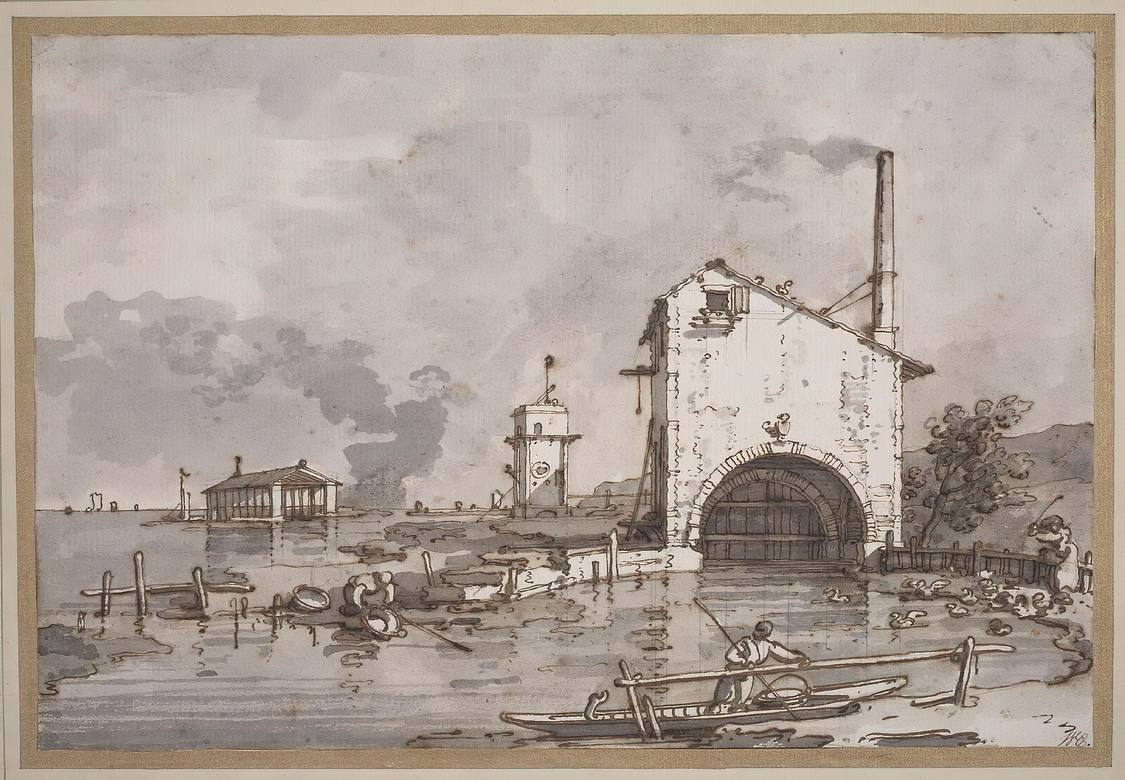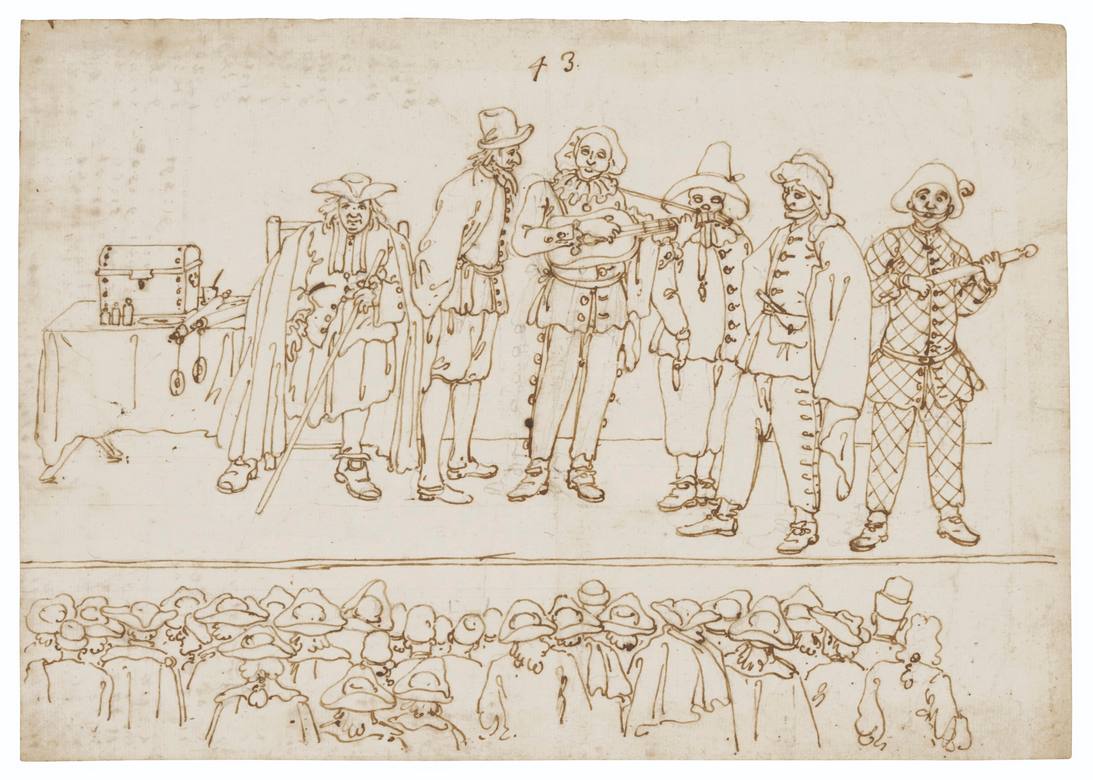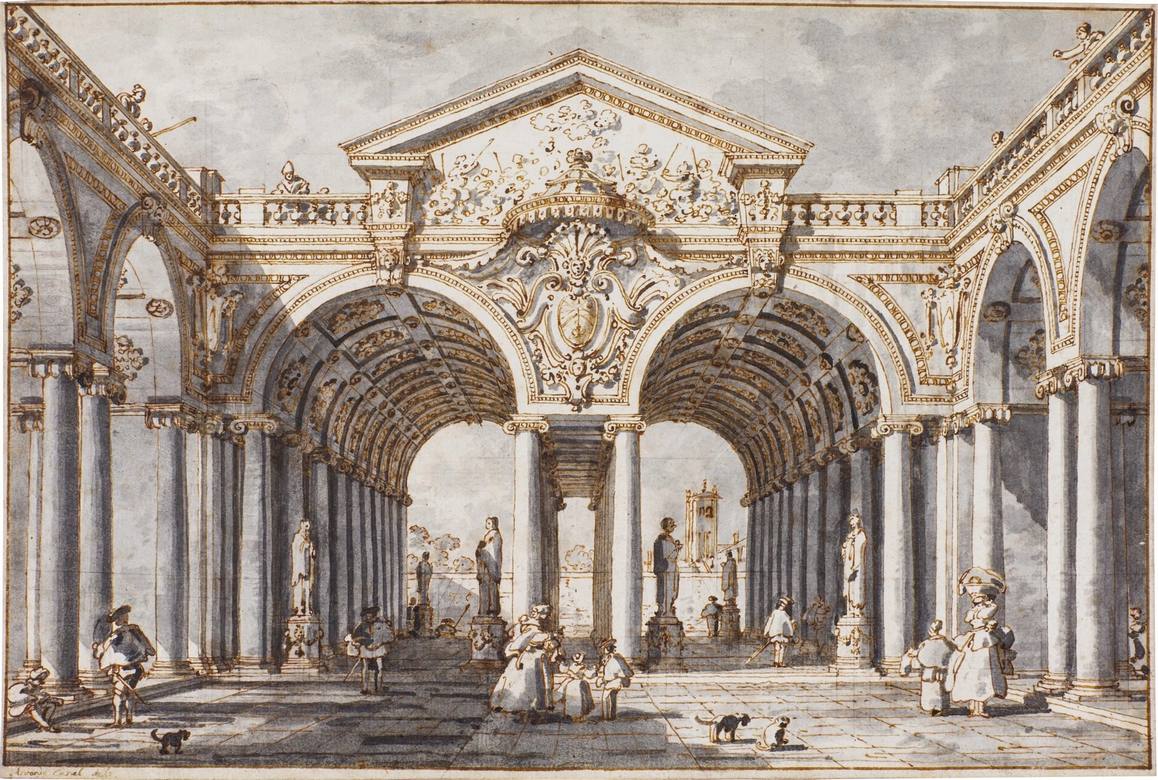
DRAWINGS
What they are
and why they are so important
Drawings are usually considered as a "first step which leads to a painting", and they can so be considered also in Canaletto's case.
But not all the time, in reality, because Canaletto's more elaborate drawings are very much like paintings by themselves, after all, with all the needed details and perfectionism, only without the color.
The same perfection Canaletto was attaining in his paintings, he was putting in the drawings, so the same care, emotion, life of his paintings, can be found in his drawings too.
And sometimes more, because: if a painting (Rococo Era!) can be considered a process of re-creating reality as closely as possible, a drawing may mimic that reality (without color!), but its immediateness (with Canaletto this is something that needs some extra analysis, though) and freedom of creating lines and surfaces, goes beyond reality itself, ends up more in the dream domain.
Canaletto's drawings do have incredible three-dimensionality, depth, presence, dynamics, as his paintings have, of course.
It would really be interesting to know how much time Canaletto would dedicate to each drawing - the more elaborate and 3D ones, maybe, not the rough drafts or sketches - to be possible to closely understand his creation/production process.
As much as he was doing the drawings to fulfill his commitments (works ones, money for sure) it must have been for him a full immersion in the subject, at that moment.
And as much as the paintings Canaletto made in his lifetime, the drawings show the energy and maniacal precision he would put in describing a situation, and all the brushstrokes he, Antonio Canal, would personally put on the canvas, and not one of his studio assistants (who? No documentation available …)
It may be here worth to give a look to his drawings in detail, to better understand his painting work and dedication and what was going on in his head that he would later transfer to his fingers.
Let's not forget that on a painting you can change what you have previously done, scrape and paint over a mistake, have a pentimento, a second thought.
But on a drawing this process is almost impossible, at least no more in the ink + pen phase, right after the pencil first drafting lines …
A drawing is (in my photographer's opinion) more like a snapshot photograph flowing from the eyes/brain setup of the artist to its final paper destination: immediateness & energy in its most crude finalization.
![Canaletto: [ca. 1745] - Venice - Piazza San Marco, looking north-east from the Procuratie Nuove - Drawing - Pen and ink, with bluish-grey wash, over free and ruled pencil and pinpointing - Royal Collection Trust, RCIN 907427](../images_db/Canaletto_1745ca__d062_Venice--Piazza-San-Marco-looking-north-east-from-the-Procuratie-Nuove--RCIN-907427.jpg)

![Canaletto: [ca.1755-60] - A capriccio with a monumental staircase - Drawing - Pen and ink, with grey wash, over ruled and free pencil and pinpointing - Royal Collection Trust, RCIN 907564](../images_db/Canaletto_1755-60ca__d027_A-capriccio-with-a-monumental-staircase--RCIN-907564-gp.jpg)

![Canaletto: [1746-47] - The City of Westminster from Near the York Water Gate - Drawing - Pen, brown ink and gray wash on thick, slightly textured, cream laid paper - Yale Center for British Art](../images_db/Canaletto_1746-47__d228_The_City_of_Westminster_from_Near_the_York_Water_Gate_2.jpg)
![Canaletto: [ca. 1725] - A villa with a garden statue in the foreground - Drawing - Pen and ink, over free and ruled pencil - Royal Collection Trust, RCIN 907554](../images_db/Canaletto_1725ca__d039_A-villa-with-a-garden-statue-in-the-foreground--RCIN-907554.jpg)
![Canaletto: [ca. 1760-68] - Landscape composition with ruins - Drawing - Pen and brown ink, with grey wash, over black chalk - British Museum, London](../images_db/Canaletto_1760-68ca__d158_Landscape-composition-with-ruins--British-Museum-105316001.jpg)
![Canaletto: [ca. 1740-60] - A capriccio with a pavilion in a walled garden, the lagoon beyond - Drawing - Pen and ink, with bluish-grey wash, over free and ruled pencil and pinpointing - Royal Collection Trust, RCIN 907543](../images_db/Canaletto_1740-60ca__d070_A-capriccio-with-a-pavilion-in-a-walled-garden-the-lagoon-beyond--RCIN-907543.jpg)
![Canaletto: [1766-67] - The Presentation of the Doge in S. Marco - Drawing - Pen and brown ink and three shades of grey wash, heightened with touches of (partly oxidised) white over black chalk, within original brown ink framing lines](../images_db/Canaletto_1766-67__d150_The-Presentation-of-the-Doge-in-S.-Marco-712L19040_7QFCN.jpg)

![Canaletto: [ca. 1742] - The Arch of Constantine - Drawing - Quill (graphic arts) - Brown ink - Ink wash - Paper - Petit Palais, Museum of Fine Arts of the City of Paris](../images_db/Canaletto_1742ca__d307_l_arc_de_constantin_ddut976_575589_Petit_Palais_Paris.jpg)
![Canaletto: [ca. 1735] - Venice - The crossing of San Marco, looking north - Drawing - Pen and ink, over ruled and free pencil - Royal Collection Trust, RCIN 907430](../images_db/Canaletto_1735ca__d065_Venice--The-crossing-of-San-Marco-looking-north--RCIN-907430.jpg)
![Canaletto: [ca. 1740-45] - A capriccio of the Fontegheto della Farina - Drawing - Pen and ink, with grey wash, over free and ruled pencil and pinpointing - Royal Collection Trust, RCIN 907463](../images_db/Canaletto_1740-45ca__d047_A-capriccio-of-the-Fontegheto-della-Farina--RCIN-907463-gp.jpg)
![Canaletto: [1763-66] - The Doge leaving the Church of San Zaccaria on Easter Day - Drawing - Pen and brown ink and grey wash, heightened with white (oxidised), over black chalk (much of it drawn with the aid of a ruler) - British Museum, London](../images_db/Canaletto_1763-66__d155_The-Doge-leaving-the-Church-of-San-Zaccaria-on-Easter-Day--British-Museum-63103001.jpg)
![Canaletto: [ca. 1723-24] - Venice - The Piazzetta looking north - Drawing - Pen and ink, over a few traces of free pencil - Royal Collection Trust, RCIN 907443](../images_db/Canaletto_1723-24ca__d102_Venice--The-Piazzetta-looking-north--RCIN-907443.jpg)

![Canaletto: [ca. 1740-60] - A capriccio of church ruins on the shores of the lagoon - Drawing - Pen and ink, with bluish-grey wash, over free and ruled pencil and pinpointing - Royal Collection Trust, RCIN 907528](../images_db/Canaletto_1740-60ca__d073_A-capriccio-of-church-ruins-on-the-shores-of-the-lagoon--RCIN-907528.jpg)
![Canaletto: [ca. 1735-40] - Venice - San Simeon Piccolo - Drawing - Pen and ink - Royal Collection Trust, RCIN 907467](../images_db/Canaletto_1735-40ca__d092_Venice--San-Simeon-Piccolo--RCIN-907467.jpg)

![Canaletto: [1760-68] - View through a Baroque Colonnade into a Garden - Drawing - Pen and brown ink, black-gray wash in two tones, partly visible perspective construction lines in black pencil - Albertina Museum, Vienna - Courtesy: Google Art Project](../images_db/Canaletto_1760-68__d143_view-through-a-baroque-colonnade-into-a-garden-Goog.jpg)
![Canaletto: [ca. 1735-40] - Venice - Campo Santo Stefano - Drawing - Pen and ink, over free and ruled pencil and pinpointing - Royal Collection Trust, RCIN 907480](../images_db/Canaletto_1735-40ca__d113_Venice--Campo-Santo-Stefano--RCIN-907480.jpg)
![Canaletto: [ca. 1763-66] - The Doge carried around St Mark's Square before his Coronation - Drawing - Pen and brown ink, with grey wash, heightened with white (oxidised), over black chalk (much of which drawn with the ruler) and some red chalk - British Museum, London](../images_db/Canaletto_1763-66ca__d200_The-Doge-carried-around-St-Mark's-Square-before-his-Coronation--British-Museum-63105001.jpg)
![Canaletto: [ca. 1760] - Padua - The Benavides garden, with a classical arch and a statue of Hercules - Drawing - Pen and ink, with grey wash, over free and ruled pencil and pinpointing - Royal Collection Trust, RCIN 907563](../images_db/Canaletto_1760ca__d022_Padua--The-Benavides-garden-with-a-classical-arch-and-a-statue-of-Hercules--RCIN-907563.jpg)
![Canaletto: [ca. 1742] - Rome - A distant view of Santa Maria in Cosmedin and Ponte Rotto - Drawing - Pen and ink, over free and ruled pencil and pinpointing - Royal Collection Trust, RCIN 907516](../images_db/Canaletto_1742ca__d089_Rome--A-distant-view-of-Santa-Maria-in-Cosmedin-and-Ponte-Rotto--RCIN-907516.jpg)
![Canaletto: [1758] - Campo San Giacomo di Rialto, Venezia (Campo San Giacomo di Rialto, Venice) - Drawing - Pen and brown ink](../images_db/Canaletto_1758__d205_Campo-San-Giacomo-di-Rialto--Venezia-511253ld.jpg)
![Canaletto: [ca. 1740-60] - A capriccio with a bridge crossing a river - Drawing - Pen and ink, with bluish-grey wash, over free and ruled pencil and pinpointing - Royal Collection Trust, RCIN 907541](../images_db/Canaletto_1740-60ca__d076_A-capriccio-with-a-bridge-crossing-a-river--RCIN-907541.jpg)
![Canaletto: [ca. 1750-55] - A Palace with a Courtyard by the Lagoon - Drawing - Pen and brown ink and brush and gray and black wash over traces of graphite - The Cleveland Museum of Art](../images_db/Canaletto_1750-55ca__d306_Capriccio_A_Palace_with_a_Courtyard_by_the_Lagoon_(797137)-gp1.jpg)